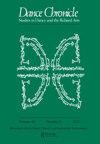重塑拜占庭舞蹈 XOPÓΣ:亚当之舞。拜占庭舞蹈学的形成,拜占庭舞蹈合唱团的人类学》,Nicoletta Isar 著。448 页。有插图。莱顿:亚历山大出版社,2011 年。纸质版 250 欧元。ISBN: 78-94-90387-04-4 纸质版。 Elemental Chorology:Vignettes Imaginales 作者:Nicoletta Isar。448 页。有插图。莱顿:亚历山大出版社,2020 年。纸质版 250 欧元。ISBN: 978-90-80 64760-2 纸质版。
IF 0.5
3区 艺术学
0 DANCE
引用次数: 0
摘要
*伊萨尔借用了约翰·萨利斯(John Sallis)的“编年史”一词,萨利斯将其应用于柏拉图《蒂迈奥》中对宇宙古老而神秘的形成的研究,见萨利斯,《编年史:柏拉图《蒂迈奥》的开端》(布卢明顿:印第安纳大学出版社,1999年)Nicoletta Isar,“亚当之舞:重建拜占庭Chorós”,Byzantinoslavica 61 (2003): 179-204.2 Alexei Lidov,“崇拜:作为一种创造形式和文化历史主题的神圣空间的创造”,在崇拜:拜占庭和中世纪俄罗斯的神圣空间的创造,Alexei Lidov编辑(莫斯科:Progress-Tradition, 2006), 32-58.3 Lidov,“崇拜”,36.4 Mircea Eliade,神圣和亵渎:宗教的本质,由Willard Trask翻译(纽约:Harcourt, Brace, and World, Inc., 1957), 20-29.5 Nicoletta Isar,“编学(ch本文章由计算机程序翻译,如有差异,请以英文原文为准。
Reimagining Byzantine Dance XOPÓΣ: The Dance of Adam. The Making of Byzantine Chorography, The Anthropology of the Choir of Dance in Byzantium By Nicoletta Isar. 448 pp. Illustrated. Leiden: Alexandros Press, 2011. €250 paper. ISBN: 78-94-90387-04-4 paper. Elemental Chorology: Vignettes Imaginales By Nicoletta Isar. 448 pp. Illustrated. Leiden: Alexandros Press, 2020. €250 paper. ISBN: 978-90-80 64760-2 paper.
Click to increase image sizeClick to decrease image size Notes* Isar borrows the term chorology from John Sallis, who applied it to his study of the archaic and enigmatic making of the cosmos in Plato’s Timaeus, see Sallis, Chorology: On Beginning in Plato’s Timaeus (Bloomington: Indiana University Press, 1999).1 Nicoletta Isar, “The Dance of Adam: Reconstructing the Byzantine Chorós,” Byzantinoslavica 61 (2003): 179–204.2 Alexei Lidov, “Hierotopy: The Creation of Sacred Spaces as a Form of Creativity and Subject of Cultural History,” in Hierotopy: Creation of Sacred Spaces in Byzantium and Medieval Russia, edited by Alexei Lidov (Moscow: Progress-Tradition, 2006), 32–58.3 Lidov, “Hierotopy,” 36.4 Mircea Eliade, The Sacred and the Profane: The Nature of Religion, translated by Willard Trask (New York: Harcourt, Brace, and World, Inc., 1957), 20–29.5 Nicoletta Isar, “Chorography (Chȏra, Chorós) – A Performative Paradigm of Creation of Sacred Space in Byzantium,” in Hierotopy: Creation of Sacred Spaces in Byzantium and Medieval Russia, edited by Alexei Lidov (Moscow: Progress-Tradition, 2006), 59–90.6 Julia Kristeva, Revolution in Poetic Language, translated by Margaret Waller (New York: Columbia University Press, 1984 [1974]).7 Bissera Pentcheva, The Sensual Icon: Space, Ritual, and the Senses in Byzantium (University Park: Pennsylvania State University Press, 2010), 155–82.8 Kimerer LaMothe, Why We Dance: A Philosophy of Bodily Becoming (New York: Columbia University Press, 2015).9 Robert Farris Thompson, African Art in Motion: Icon and Act (Berkeley: University of California Press, 1974); Thompson, “An Aesthetic of the Cool: West African Dance,” African Forum 2, no. 2 (1966): 85–102.10 Alfred Gell, Art and Agency: An Anthropological Theory (Oxford: Clarendon Press, 2013 [1998]).Additional informationNotes on contributorsKathryn DickasonKATHRYN DICKASON is a Public Relations Specialist at Simmons University in Boston. She has a PhD in Religious Studies from Stanford University and has published widely on Western medieval dance, iconography, literature, and sign theory. Her first book, Ringleaders of Redemption: How Medieval Dance Became Sacred, was published in 2021 by Oxford University Press. Currently, she is guest editing a special issue of postmedieval: A Journal of Medieval Cultural Studies on the legacies of medieval dance and is writing her second book on Western medieval dance iconography.
求助全文
通过发布文献求助,成功后即可免费获取论文全文。
去求助
来源期刊

DANCE CHRONICLE
DANCE-
CiteScore
0.40
自引率
0.00%
发文量
22
期刊介绍:
For dance scholars, professors, practitioners, and aficionados, Dance Chronicle is indispensable for keeping up with the rapidly changing field of dance studies. Dance Chronicle publishes research on a wide variety of Western and non-Western forms, including classical, avant-garde, and popular genres, often in connection with the related arts: music, literature, visual arts, theatre, and film. Our purview encompasses research rooted in humanities-based paradigms: historical, theoretical, aesthetic, ethnographic, and multi-modal inquiries into dance as art and/or cultural practice. Offering the best from both established and emerging dance scholars, Dance Chronicle is an ideal resource for those who love dance, past and present. Recently, Dance Chronicle has featured special issues on visual arts and dance, literature and dance, music and dance, dance criticism, preserving dance as a living legacy, dancing identity in diaspora, choreographers at the cutting edge, Martha Graham, women choreographers in ballet, and ballet in a global world.
 求助内容:
求助内容: 应助结果提醒方式:
应助结果提醒方式:


